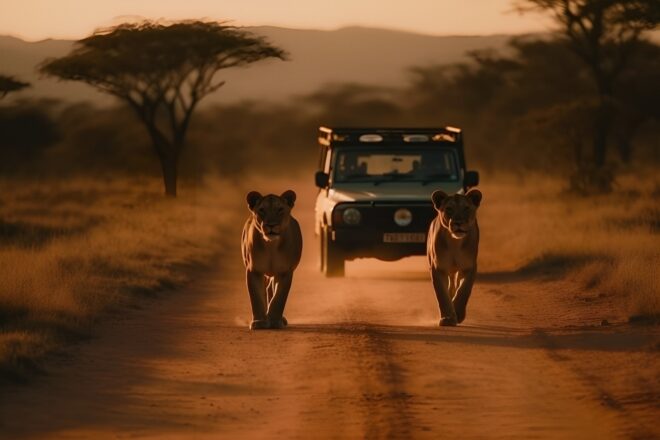The savannah, a breathtaking landscape teeming with diverse wildlife, faces significant threats from human activity. From poaching to habitat destruction, the delicate balance of these ecosystems is under constant pressure. However, a growing trend toward sustainable tourism is offering a beacon of hope. By promoting eco-friendly practices, sustainable tourism initiatives are playing a pivotal role in conserving the wildlife of the savannah. Stephen Wentzel of Zimbabwe delves into how these initiatives are making a difference, highlighting successful examples and exploring the benefits and challenges of this approach.
The Importance of the Savannah Ecosystem
The savannah is home to an incredible array of species, including iconic animals like elephants, lions, zebras, and giraffes. These ecosystems are not only vital for the animals that inhabit them but also for the overall health of our planet. Savannahs play a crucial role in carbon sequestration, water filtration, and maintaining biodiversity. Despite their importance, human encroachment and climate change are severely impacting these areas. Sustainable tourism offers a viable solution to help mitigate these effects.
What is Sustainable Tourism?
Sustainable tourism is an approach that aims to minimize the negative impacts of tourism while maximizing its benefits for local communities and environments. It involves practices that are ecologically sound, economically viable, and socially equitable. In the context of wildlife conservation in the savannah, sustainable tourism focuses on protecting habitats, supporting conservation projects, and promoting responsible tourist behavior.
How Sustainable Tourism Supports Wildlife Conservation
- Funding and Economic Incentives
One of the most direct ways sustainable tourism supports wildlife conservation is through funding. Entrance fees, guided tours, and eco-lodge stays often include contributions to conservation projects. For example, many safari operators in East Africa allocate a portion of their profits to anti-poaching units, wildlife research, and habitat restoration.
Tourists willing to pay a premium for eco-friendly experiences provide essential funding that might otherwise be difficult to secure. This financial support helps maintain protected areas, purchase necessary equipment for rangers, and fund community education programs about conservation.
- Community Involvement and Empowerment
Sustainable tourism initiatives often involve local communities, ensuring they benefit directly from tourism revenue. By providing employment opportunities and supporting local businesses, these initiatives help reduce the reliance on activities that harm wildlife, such as poaching and unsustainable agriculture.
For instance, in Kenya’s Maasai Mara, community conservancies have been established where local Maasai people are involved in managing tourism operations. They receive a share of the revenue, which incentivizes them to protect wildlife. This model has proven successful in reducing poaching incidents and preserving the savannah’s natural beauty.
- Education and Awareness
Educating tourists about the importance of wildlife conservation is a key component of sustainable tourism. Eco-tour operators often provide information on how visitors can minimize their impact and encourage practices such as reducing waste, respecting wildlife, and supporting conservation efforts.
Moreover, tourists who return home with a deeper understanding of conservation issues often become advocates for wildlife protection, further spreading awareness and support for these vital efforts.
- Research and Monitoring
Sustainable tourism can also contribute to wildlife research and monitoring. Many eco-friendly lodges and tour operators collaborate with scientists to gather data on animal behavior, population numbers, and ecosystem health. This research is crucial for developing effective conservation strategies.
For example, in South Africa’s Kruger National Park, tourists can participate in citizen science programs where they help track animal movements and report sightings. The collection of this data is invaluable for researchers and helps involve tourists directly in conservation efforts.
- Habitat Restoration and Protection
Protecting and restoring habitats is a fundamental aspect of wildlife conservation. Sustainable tourism initiatives often include efforts to rehabilitate degraded areas, control invasive species, and maintain natural landscapes. These efforts help ensure that wildlife has the space and resources necessary to thrive.
In Tanzania’s Serengeti National Park, for instance, eco-tourism operators work with park authorities to reforest areas and protect water sources. These projects not only benefit the wildlife but also enhance the overall visitor experience, creating a positive feedback loop where better conservation leads to more appealing tourism opportunities.
Challenges and Future Directions
While sustainable tourism offers many benefits, it is not without challenges. Ensuring that tourism activities do not disrupt wildlife or damage habitats requires careful planning and management. There is also the challenge of balancing the needs and expectations of tourists with conservation goals.
Moreover, the success of sustainable tourism initiatives often hinges on the support of local governments and communities. Effective regulation and enforcement are essential in order to prevent over-tourism and ensure that eco-friendly practices are genuinely implemented.
Looking forward, the future of sustainable tourism in the savannah will depend on continuous innovation and collaboration. Developing new ways to engage tourists in conservation, leveraging technology for better monitoring, and fostering stronger partnerships between stakeholders will remain crucial.
Sustainable tourism is a powerful tool for supporting wildlife conservation in the savannah. By providing essential funding, involving local communities, educating tourists, and aiding research and habitat restoration, eco-friendly tourism initiatives are making a tangible difference. As more travelers seek out responsible and meaningful experiences, the potential for sustainable tourism to contribute to wildlife conservation will only grow. Ensuring that this potential is fully realized requires ongoing commitment and cooperation from all involved. The beauty and biodiversity of the savannah are worth the effort, promising a brighter future for both wildlife and people.
